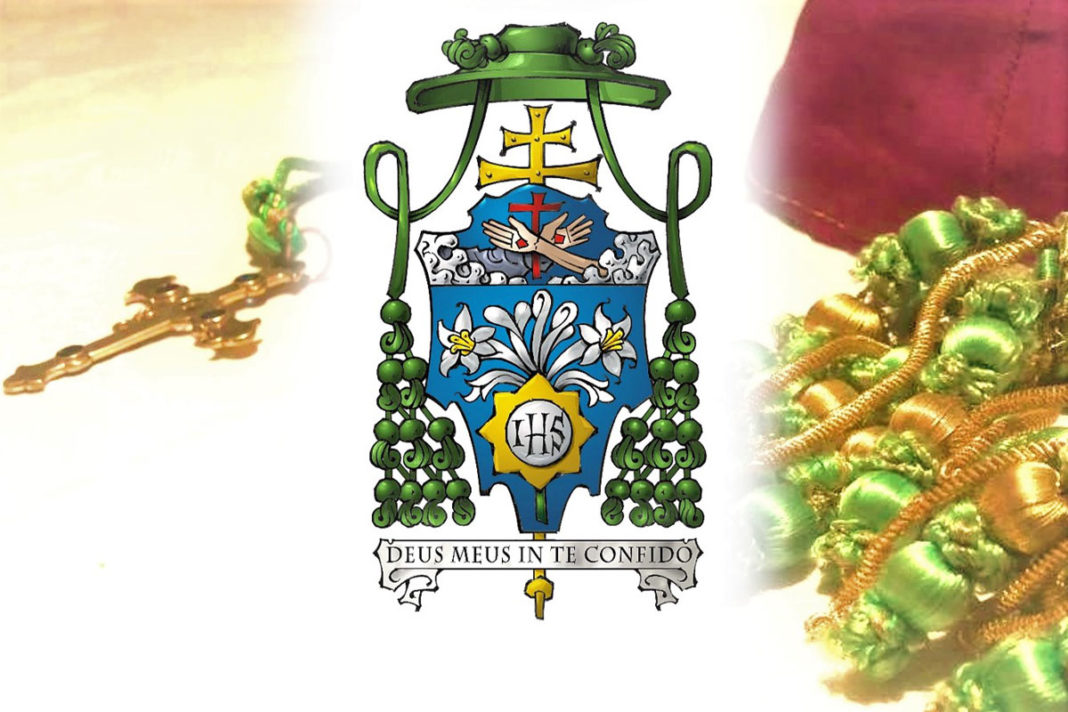The archiepiscopal coat of arms bears the insignia of heraldry: the green galero, with ten tassels per side, arranged in four rows, and the cross with two traverses.
On the iconographic level, within the shield, the image at the top represents the Order of Friars Minor Conventual to which Archbishop Dominique MATHIEU belongs. The center section shows images that refer to inspirational elements of his pastoral ministry. Finally, there is the episcopal motto at the bottom.
The upper section of the shield shows the emblem of the Archbishop’s Order of origin. From the stylized clouds, two crossed arms are seen. The arm that is sleeved in a gray habit belongs to St. Francis of Assisi; his hand bears the stigmata. The bare arm belongs to Christ. The red cross recalls His passion and redemption.
This is the emblem of the Minorite Order and is called Conformitas. It proclaims the perfect discipleship that St. Francis wanted to embody, the conformation of himself to the Crucified Jesus, at every level, out of love, to the point of becoming an alter Christus.
The blue background of the shield represents the beauty and depth of the mysteries of the Kingdom of Heaven. It also refers to the mantle of the Immaculate Virgin Mary, who with her assent, fully participates in the universal plan of salvation.
The symbolism at the center of the shield shows an eight-pointed golden-yellow star, formed by two squares, called the “Persian star.” It symbolizes the shining star that the Magi, coming from the East, followed to encounter Christ, the True Light. The star also depicts a geometric shape typical of the Iranian region. In fact, the square part of it, which connects the four cardinal points, is the symbol of the created universe – earth and sky – and of justice. It is a static geometric figure. By adding a second square and turning it forty-five degrees, an octagon is created, suggesting the concept of movement and divine reality.
The star also recalls Mary Most Holy, the guide of travelers or those seeking a homeland. She is invoked with the ancient title of Stella Maris, emphasizing her role as the Mother of the Lord, a sign of hope and a guiding star for Christians.
The pure white disc, a symbol of the perfection and transcendence of the Creator, with the Latin abbreviation, IHS, taken from the Greek name of Jesus, together represents the vitality and purity of the Eucharistic Bread and the immense potential that it can confer through the Word made flesh.
The two juxtaposed symbols are combined to demonstrate how Creation, finite and mortal, must find its completion in the Creator in order to achieve true harmony.
Springing up from these symbols is a fragrant sprig of blooming nard, a plant whose oil is a symbol of devotion and spirituality. It also symbolizes St. Joseph, Spouse, who co-operates discreetly and gently in God’s plan to help each believer grow, find strength and be filled with wisdom.
By joining themselves together with their shepherd Christ, the Highest Good, the faithful will seek to be living leaven in the dough of a generous and wise people on their way to ever greater perfection. They will sanctify themselves discreetly after the example of Mary Most Holy, the “palace, tabernacle and dwelling” of the Son of God, and of her husband St. Joseph. The heart of this Church will then be the incandescent abode of the Holy Spirit, the shining star for those who seek light.
Finally, the new Archbishop’s motto is taken from the first part of verse 2 of Psalm 25: “My God, in you I trust!” It is an invitation to totally entrust our lives to God, as the Virgin Mary did. Moreover, it is the indispensable condition to be able to rejoice in the Word and bear fruit. Indeed, the Lord will never disappoint us because he is faithful to his promise: “I am with you always, until the end of the age” (cf. Mt 28:20).
Office of Communications
















